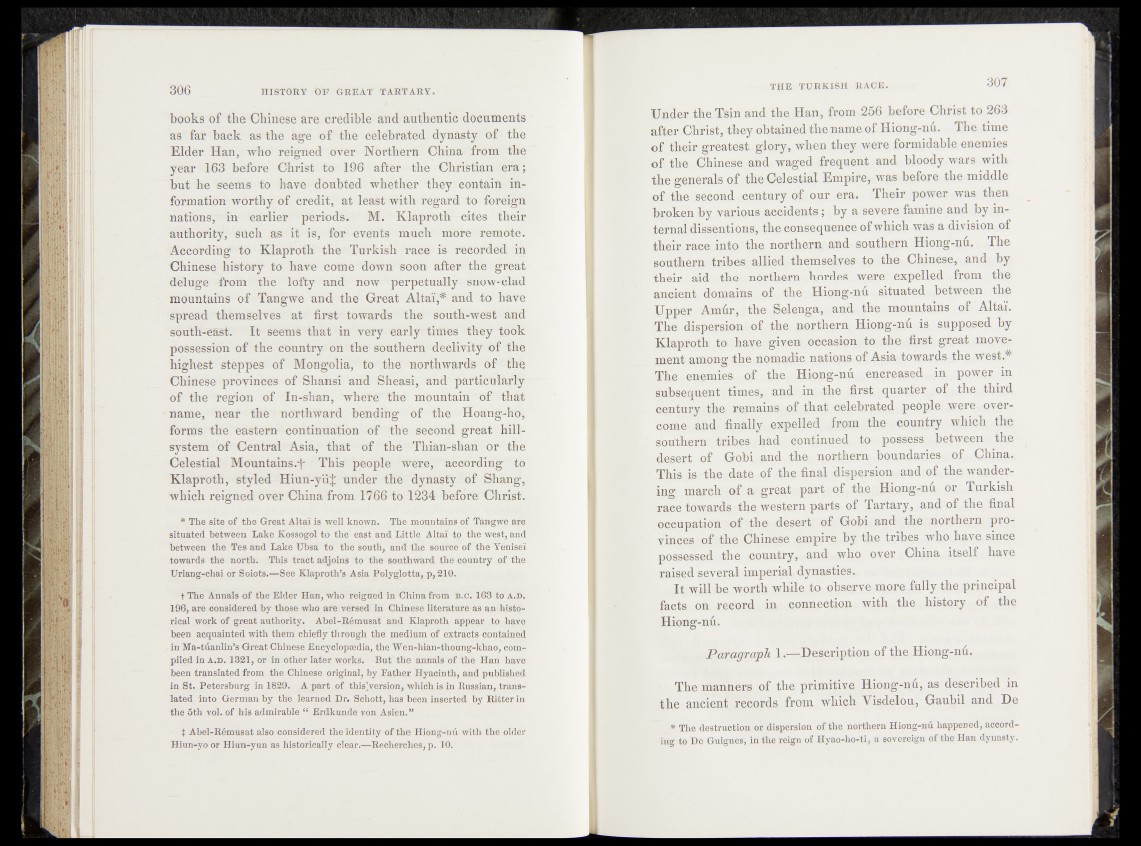
books of the Chinese are credible and authentic documents
as fat back as the age of the ^c'èlèbrated dynasty of thq
Elder Han, who reigned brer Northern China from the
year 163 before Christ to 196 after the Christian era ;
but he seems to havë^ doubted whether they cbntbhfe information
worthy of credit, at least with regard to foreign
nations, in earlier periods. M. Klaproth - cités their
authority, such as it is, for events much more remote.
According to Klaproth the- Turkish race is recorded in
Chinese history to have come down soon after the great
deluge-from the lofty and now perpetually snow-clad
mountains of Tangwe and the Great Altaï,# and to have
spread - themselves at first towards the south-west and
south-east. It seems that in very early times they.took
possession of the country on the southern declivity of the
highest steppes of Mongolia, to the northwards of the
Chinese provinces of Shansi and Sheasi, and particularly
of the region of In-shan, where the mountain of that
name, near the northward bending of the Hoang-bÉ,
forms the eastern continuation of the second great hill-
system of Central Asia, that of the Thian-shan or- the
Celestial Mountains.^* This people were, according to
Klaproth, styled Iliun-yiiJ under the dynasty of Shang,
which reigned over China from 1766 to 1234 before Christ.
* The site of the Great Altaï is. well known. The mountains of Tangwe are
situated between Lake Kossogol to the east and Little Altain|£ the wést, and
between the Tes and Lake Ubsa to the south, and the source of the Yenisei
towards the north-. This tract adjoins to the southward the cpuntry of the
Uriang-chai or Soiots.—See Klaproth’s Asia Polyglotta, p, 210.
t The Annals of the Elder Han, who reigned in-China from b.C. 163 to A.d.
196, are considered by those who are versed in Chinese literature as an historical
work of great authority. Abel-Rémusat and Klaproth appear to have
been acquainted with them chiefly through the medium of extracts contained
in Ma-tuanlin’s Great Chinese Encyclopaedia, the Wen-hian-thoung-khao, compiled
in a.d. 1321, or in other later works. But the annals of the Han have
been translated from the Chinese original, by Father Hyacinth, and published
in St. Petersburg in 1829. A part of this'version, which is in Russian, translated
into German by the learned Dr. Schott, has been inserted by Ritter in
the 5th vol. of his admirable “ Erdkunde von Asien.”
• i Abel-Rémusat also considered the identity of the Hiong-nû with the older
Hiun-yoor Hiun-yun as historically clear.—Recherches, p. 10.
Upde^the Tsin and the Han, from £56 before Christ to 263
after -they^btai^eilthe name.of Hiong-nü. The time
o f their greatest glar^,, when tl^w e r e formidable enemies
of th e , Ch$n&$ and waged frequent and bloody wars with
the generals of the^^S-tial Empire-, was before the middle
of . fhe^->epoadr(.century b^;puri era; Their power was then
broken by various accidents,!, by a severe famine and by internal
dissentionsv the consequence of which was a division of
their race inf^-the-northern an^southern Hiong-nü. The
southern tribes allied «.themseLyef to the Chinese, and by
their aid the ;pèHhern-,h;or^es} were;impelled from the,
ancient domains o f . the - Hiongj-nu situated {tbel;weeb the
Hpper. Amür, the; gejenga, tand . the mountains of Altai.
The dispersion ^o£ the northern Hiongs&|?jjh supposed by
Klaproth to have given- occasion^tq|ithe^,first great movement
among the nomadic nations of Asia- towards the.west.^
The ;en§mies; the Hiqng-hp«enereascd... in power in
subsequent . ‘times,, and in the ,quarteriltof .the third
century the., remains of that, c^l.ebratecl people were,^oyer-
©eme and finally expelled ,& o a the country whi^k the
southern Vibes had ; continued possess -between; the
desert, of. Gobi and the northern b.QWda^ies^pf .China.
This;iis the date^of .4b© bnal dispersion and,of the wandering
march of a great part, of. t|i^ Hiong^nu-4 or Turkish
race'towards the western parts of Tapt^ry., and of. .the final
occupation ? of the desert of- Gobi and the. northern provinces
of the ^Chinese .t^aapire, by thp tribpe, whq.have since
possessed the country, and *,w,bö\ oyer. China, itself have
raised several imperial- dynastiesv
It will be worth while, p obsprye-more fully, thq^ripcipal
facts on record in connection with the., history of the
Hiong-nü.
Paragraph 1.—Description of the Hiong-nü. v
' The manners of,, the primitive Hiong-nü, as described in
the ancient records’,from, which Visdelou, Gaubil and De
‘ <* The destruction ói dispersion of the northern Hiong-nu happened, according
to De Guignes, in the reign of Hyao-ho-ti, a sovereign of the Han dynasty.